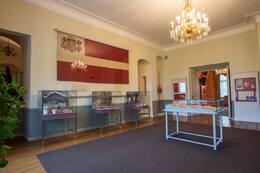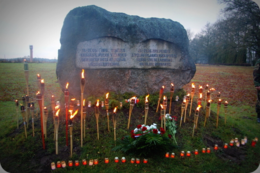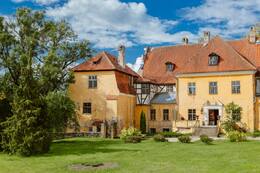Cėsių mūšių pėdsakais
Diena 2.
145 km
Cēsis–Stalbe–Straupe–Limbaži–Rīga
Praktinė informacija
- Driving distance: 145 km
- The Escape game in New Castle of Cēsis is available for 2–5 persons, on a previous arrangement
- Excursion in Cēsis castle complex cesupils.lv/en
- Lielstraupe Castle is open on Wednesdays 9–17 and Saturdays 12–16 for individual visits. For group visits with previous arrangements orienteering game is available (min. 10 persons) and guide services +371 29464946. The territory of the castle is open for visiting 24/7
Lankytinos vietos
Cēsis history and art museum in the New Castle of Cēsis
The Cēsis History and Art Museum is located in the very centre of the Old Town of Cēsis, in the New Castle. The museum holds a permanent exhibit of history and interiors named ‘Cēsis, a Symbol of Latvian History’, with two thematic sections: the exhibit ‘Red-White-Red Flag in the History of Cēsis and Latvia’ explains the history of the Latvian national flag from the 13th to 20th centuries, the approved national symbol, the flags of Latvian rifle battalions and the traditions of using national colours during the Latvian War of Independence. The exhibit ‘Cēsis and the Latvian War of Independence’ focuses on the founding of the Cēsis Company in December 1918, the joint battle efforts of Estonians and Latvians in the 1919 Battles of Cēsis, the time when, during the Bermondt Affair, Cēsis served as the temporary capital of Latvia for a short time, as well as the history of the Cēsis Victory Monument. In an escape room named ‘Legends of the Battles of Cēsis’, the participants have one hour to find their way out by solving puzzles, making connections and finding hidden objects. The Cēsis Company, one of the first units of the Latvian Armed Forces, was established on 8 December 1918 in Cēsis Castle by Senior Lieutenant Artūrs Jansons. The museum’s exhibit features a memorial plaque dedicated to the Cēsis Company, unveiled on 8 December 1933 at the Cēsis New Castle, which, at the time, served as the headquarters of the 8th Daugavpils Infantry Regiment and the garrison officers’ club.
Monument for students of the Viljandi Regiment
The monument to the soldiers of the Viljandi Students’ Company who fell near Stalbe is located by the intersection of the Riga-Limbaži road, after making a turn onto the Stalbe-Stūrīši road, which leads to the Pārgauja Municipal Council (to the right). Latvian and Estonian inscriptions on the granite memorial read: ‘On 19-21 June 1919, during the Battles of Stalbe, the 6th Regiment Viljandi Students’ Company repelled the attack of the Germans’. The monument was unveiled on 19 June 2009. Based on the idea conceived by Mareks Niklass, the monument was created by stonemason Voldemārs Koltovs. The 6th Estonian Regiment fought the Baltic Landeswehr and the Iron Division during the Battles of Cēsis near Stalbe. The Germans tried to break the front line in the area of the Stalbe Manor but were forced to retreat after two days of failed attempts. Every year, Lāčplēsis Day celebrations in Stalbe begin with a torchlight procession to the monument devoted to the soldiers of the Viljandi Students’ Company.
Lielstraupe Castle
The Lielstraupe Castle is located in the centre of the town of Straupe. The castle is open to visitors and offers a journey through the centuries along with an orienteering exercise in the labyrinths of the castle. During the Battles of Cēsis, the Lielstraupe Castle housed the command post of Paul Ludwig Ewald von Kleist’s Battle Group of the Iron Division (German: Eiserne Division). During the battles, the castle was visited by Major Josef Bischoff, Captain Heinz Guderian and others. The castle was used for the coordination of an attack in the direction of Stalbe on 21-22 June. The Iron Division was a military force of German mercenaries during the Latvian War of Independence, which was formed from soldiers of the 8th Army of the demobilised German Empire and volunteer mercenaries. It was the best-known part of the German Free Corps and among the best trained and most combat-ready military forces in the Baltics in 1919. During the Soviet period, from 1949 to 1959, the administration of the Lielstraupe Machine-tractor Station operated out of Manor Castle. During this time, the castle was also equipped with training rooms and dormitories for tractor drivers, while the former stable of the manor housed workshops. From 1963 to 2018, the castle was managed by medical institutions, and it was said of the Straupe Narcological Hospital in Latvia that it ‘even treats the walls’.
Monument in memory of the fallen soldiers of the Latvian Liberation War
The monument is located next to Limbaži Sv. St. John's Lutheran Church, Lībiešu Street 2. There is a memorial to the fallen soldiers of Limbaži and the surrounding area and to Lieutenant General Vilis Gelbe (1890-1919), who fell in the battle against the Germans on June 19, 1919 in Vidriži.
The monument of Lieutenant General Viļis Gelbe can be seen in the Limbaži cemetery in Jūras Street.
Vietos pavalgyti
Apaļkalns
Ungurmuiža restaurant
The restaurant is in the “old school” of Ungurmuiža. Together with the nobleman’s estate and park, this makes up a unique cultural and historical monument.
Latvian cuisine: Potato pancakes with cured meet and loganberry jam, chanterelles soup, vegetable soup, porridge with meat, Brasla trout, roast pork with rhubarb sauce, manna, desserts with berry sauce.
Igate castle Mill cafe
The saloon is at the edge of the Murjāņi-Limbaži road (P9) and alongside the Igate Castle. It is built on the foundations of a former windmill, and the wheel of the mill has been preserved. The old watermill is still hard at work and is used to mill grain for traditional porridge and buns. The saloon works with local farmers.
Latvian cuisine: Mushroom soup, barley porridge with meat, barley buns, grit sausage with lingonberry sauce, crepes with jam, potato pancakes, fried plaice or pike, stacked rye bread.
Special foods: Sautéed rabbit, stuffed filet of turkey.
The “Raganas ķēķis” saloon
The saloon is on the edge of the Murjāņi-Valka road (A3) and is easily recognised because of the building and various fairy tale characters in the yard.
Latvian cuisine: Cold soups (beet, bean, sauerkraut, sorrel), roast leg of pork, blood sausage, pork ribs, berry dessert with toasted oats, stacked rye bread.
Special foods: “Fiery Soup of the Ragana Kitchen”.
The Birini Castle
The Bīriņi estate complex and the park was built in the 18th-19th century. The castle itself was built in 1860, and exemplifies a successful mixture of styles - the architecture is dominated by the Neo-gothic and semicircle style, while the interior features Neo-renaissance. Today the castle is a prestigeous venue for banquets and seminars. Apart the function rooms, there is a hotel and a restaurant and taverna which invite travelers to have a rest from the city' s hustle and enjoy the romantic surroundings of the castle.
In Limbaži visitlimbazi.lv/en/in-limbazi







![Limbaži. Valsts prezidents J. Čakste atklāj pieminekli Limbažos I Pasaules karā kritušajiem. Latvijas Brīvības cīņu pieminekļa atklāšana [1923]. Avots: Latvijas Nacionālās bibliotēkas digitālais krājums "Zudusī Latvija".](/g/Poi/00403/44213.png?size=260)

